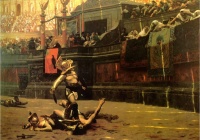Circus Maximus
From The Art and Popular Culture Encyclopedia

Illustration: Pollice Verso by Jean-Léon Gérôme, 1872
|
Related e |
|
Featured: |
The Circus Maximus (Latin for greatest circus, in Italian Circo Massimo) is an ancient hippodrome and mass entertainment venue located in Rome.
Situated in the valley between the Aventine and Palatine hills, the location was first utilized for public games and entertainment by the Etruscan kings of Rome. Certainly, the first games of the Ludi Romani (Roman Games) were staged at the location by Tarquinius Priscus, the fifth Etruscan ruler of Rome. Somewhat later, the Circus was the site of public games and festivals influenced by the Greeks in the 2nd century BC. Meeting the demands of the Roman citizenry for mass public entertainment on a lavish scale, Julius Caesar expanded the Circus around 50 BC, after which the track measured approximately 621 m (2,037 ft) in length, 118 m (387 ft) in breadth and could accommodate an estimated 270,000 spectators (many more, perhaps an equal number again, could view the games by standing, crowding and lining the adjoining hills).
In 81, the Senate built a triple arch honoring Titus by the closed East end (not to be confused with the Arch of Titus over the Via Sacra on the opposite side of the Palatinum).
The emperor Domitian connected his new palace on the Palatine to the Circus in order that he could more easily view the races. The emperor Trajan later added another 5000 seats and expanded the emperor's seating in order to increase his public visibility during the games.
Chariot racing was the most important event at the Circus. The track could hold twelve chariots, and the two sides of the track were separated by a raised median termed the spina. The spina was set slightly diagonally. Statues of various gods were set up on the spina, and Augustus erected an Egyptian obelisk on it as well. At either end of the spina was a turning post, the meta, around which chariots made dangerous turns at speed. On top of the spina, there were rotatable metal dolphins that were turned down to mark laps around the course. Chariot racing was an extemely dangerous sport, frequently resulting in spectacular crashes and quite possibly the death of one or more of the contestants. One end of the track extended further back than the other, to allow the chariots to line up to begin the race. Here there were starting gates, or carceres, which staggered the chariots so that each traveled the same distance to the first turn. During these chariot races, bribery of the judge in order to fix the start of the race was very common. The race went for a total distance of about 6.5 km (4 mi).
Very little now remains of the Circus, except for the now grass-covered racing track and the spina. Some of the starting gates remain, but most of the seating has disappeared, the materials no doubt employed for building other structures in medieval Rome.
This obelisk was removed in the 16th century by Pope Sixtus V and placed in the Piazza del Popolo. Excavation of the site began in the 19th century, followed by a partial restoration, but there are yet to be any truly comprehensive excavations conducted within its grounds.
The Circus Maximus retained the honour of being the first and largest circus in Rome, but it was not the only example: other Roman circuses included the Circus Flaminius (in which the Ludi Plebeii were held), the Circus of Maxentius and the Circus of Nero.
The Circus still occasionally entertains the Romans; being a large, green area in the center of the city, it is often used for concerts and meetings. The Rome concert of Live 8 (July 2, 2005) was celebrated here, as was the Italian World Cup 2006 victory, when over 700,000 people packed in to celebrate.
On July 14, 2007 the British rock band Genesis concluded the European leg of their Turn It On Again tour by a free concert at Circo Maximus in front of 500,000+ fans.
See also

